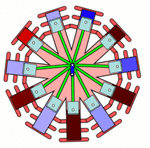Shortround6
Lieutenant General
Something sounds a little off.
Half an Allison would be 855 cu in (OK make it a bit smaller) which was rather large for a "family" plane even in the late 20s.
Popular engine in the late 20s in the US was the Wright Whirlwind 7, (there was also a 5 cylinder version) of about 225hp from 760 cu in, Used by Lindbergh and was also the early engine on the Lockheed Vega.
Another part of the story that changes is the army interest. The Army was interested, very interested, but had no money, the Navy had money so the Army suggested Allison try to get navy funds to keep the project alive. Army hoping to get more funding in later years and get involved then.
Half an Allison would be 855 cu in (OK make it a bit smaller) which was rather large for a "family" plane even in the late 20s.
Popular engine in the late 20s in the US was the Wright Whirlwind 7, (there was also a 5 cylinder version) of about 225hp from 760 cu in, Used by Lindbergh and was also the early engine on the Lockheed Vega.
Another part of the story that changes is the army interest. The Army was interested, very interested, but had no money, the Navy had money so the Army suggested Allison try to get navy funds to keep the project alive. Army hoping to get more funding in later years and get involved then.

